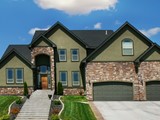Painting Mixed-Material Exteriors: Wood, Brick & Stone Strategies for Michigan Homes

When you drive through Michigan neighborhoods, it’s easy to spot the homes that turn heads. Many of them have one thing in common: a mix of exterior materials. Whether it’s wood siding paired with brick, or stone details blended with traditional trim, these homes carry a charm and character that single-material exteriors just can’t match.
But when it comes time to refresh the paint, mixed-material homes can also be a little intimidating. Each surface has different needs, and choosing the right colors takes more thought than just picking a shade you like.
That’s where strategy comes in. With the right prep work, smart color choices, and techniques that respect each surface, you can give your Michigan home a polished, cohesive look that lasts.
Why Mixed-Material Homes Stand Out in Michigan
Michigan’s housing styles are wonderfully diverse, and many feature creative combinations of materials:
- Wood siding with brick foundations or chimneys
- Brick with stone accents around entryways or porches
- Stone paired with painted wood trim or gables
These combinations give homes dimension, warmth, and a sense of permanence. But they also mean you can’t approach painting with a one-size-fits-all mindset. What works on wood might damage brick. What looks great against stone might clash if you don’t think through undertones.
On top of that, Michigan’s seasons — freezing winters, humid summers, and plenty of precipitation — can be tough on exterior finishes. Choosing the right paint system and preparing surfaces properly isn’t just about appearances. It’s about protecting your investment so your home keeps looking its best for years.
Choosing the Right Paint Colors for Mixed Materials
One of the biggest challenges (and opportunities) with mixed-material homes is color harmony. You want each material to shine, but you don’t want your exterior to look like three different houses glued together.
Here are some strategies that work especially well for Michigan homes:
- Start with the fixed elements. Brick and stone often have permanent colors and undertones. If your home has reddish brick, warm neutrals or earthy greens for wood siding will complement it beautifully. If the stone is gray with blue undertones, consider cooler paint shades like crisp whites, slate blues, or soft grays for trim and siding.
- Let one material be the star. If your brick is bold, keep wood siding or trim more neutral. On the flip side, if your siding is painted in a standout color, tone down the trim and let the stone or brick provide balance.
- Use accent colors thoughtfully. Doors, shutters, and trim are your chance to add personality. For example, cream siding with red brick pairs nicely with a deep navy front door. Or, light gray siding with stone accents can pop with black shutters and a warm wood door.
- Think in palettes, not single shades. Cohesion comes from how colors work together. A few examples:
- Warm red brick + soft beige siding + dark green shutters
- Gray stone + white trim + black front door
- Natural stone + taupe siding + slate blue accents
These combinations not only look timeless but also blend well with the natural surroundings found across Michigan neighborhoods.
Surface Prep Strategies for Each Material
Before you pick up a paintbrush, prep is key. Each surface has unique needs, and skipping steps will shorten the life of your paint job.
- Wood: This material is the most straightforward to paint, but it requires thorough prep. Scrape off peeling paint, sand rough spots, and make sure the surface is clean. A quality primer helps seal the wood and provides a smooth base for paint. Given Michigan’s moisture levels, don’t skip caulking gaps around windows and trim — it keeps water out and paint looking sharp.
- Brick: Brick can be tricky because it’s porous. Start by power washing to remove dirt and mildew. If you see a white, powdery substance (efflorescence), that has to be cleaned off or it will cause adhesion issues. Always use a breathable masonry primer before painting brick so moisture can escape — otherwise, you risk peeling and damage.
- Stone: Most homeowners don’t paint natural stone, since it’s meant to showcase its raw beauty. But you may need to paint trim, mortar lines, or wood adjacent to stonework. Take care to mask edges carefully and use brushes for precision. If you’re sealing stone or staining mortar, make sure products are designed specifically for masonry.
Taking the time to properly prep ensures the paint bonds well and protects your exterior against Michigan’s freeze-thaw cycles.
Application Techniques That Respect Each Material
Once your surfaces are prepped, the application matters just as much as the paint itself.
- Wood: Brushes and rollers work well to get into the grain, while sprayers can be helpful for large siding areas. Always follow the grain of the wood for a smooth finish.
- Brick: Masonry paint or elastomeric coatings are best for brick, since they expand and contract with the material. Apply with rollers or sprayers for even coverage, but be prepared to back-brush into mortar lines for full protection.
- Stone: Since stone is usually left natural, painting focuses on nearby trim, fascia, or siding. The key here is blending transitions so painted surfaces don’t look like an afterthought. Choosing trim colors that pull from the undertones of your stone helps everything feel intentional.
The goal is to create a seamless, unified look that highlights each material instead of hiding it.
Long-Term Maintenance & Protection
Even the best paint job won’t last forever, especially with Michigan’s weather. The good news is that with regular care, you can extend the lifespan of your exterior finishes.
- Inspect annually for peeling paint, cracked caulk, or water damage. Catching small problems early prevents bigger repairs later.
- Touch up high-exposure areas like window sills, fascia boards, or siding near gutters. These spots take the most weather-related stress.
- Schedule professional repaints every 7–10 years for wood siding, and less often for painted masonry if maintained properly.
A professional painter will also use high-quality primers and finishes designed for Michigan’s climate, giving you longer-lasting results than typical DIY products.
Bring Out the Best in Your Michigan Home
Painting a mixed-material home takes more than just picking a color and rolling it on. Each surface has its own needs, and the right combination of prep, products, and application makes all the difference. When done well, paint doesn’t just protect your home — it elevates its natural beauty and helps all those textures work together in harmony.
If you’re ready to refresh your Michigan home’s exterior, the team at Visual Paint can help. Our professional painters know how to handle wood, brick, and stone so your home looks stunning and stays protected. Contact us today for a free quote and let’s bring out the best in your home’s unique character.
